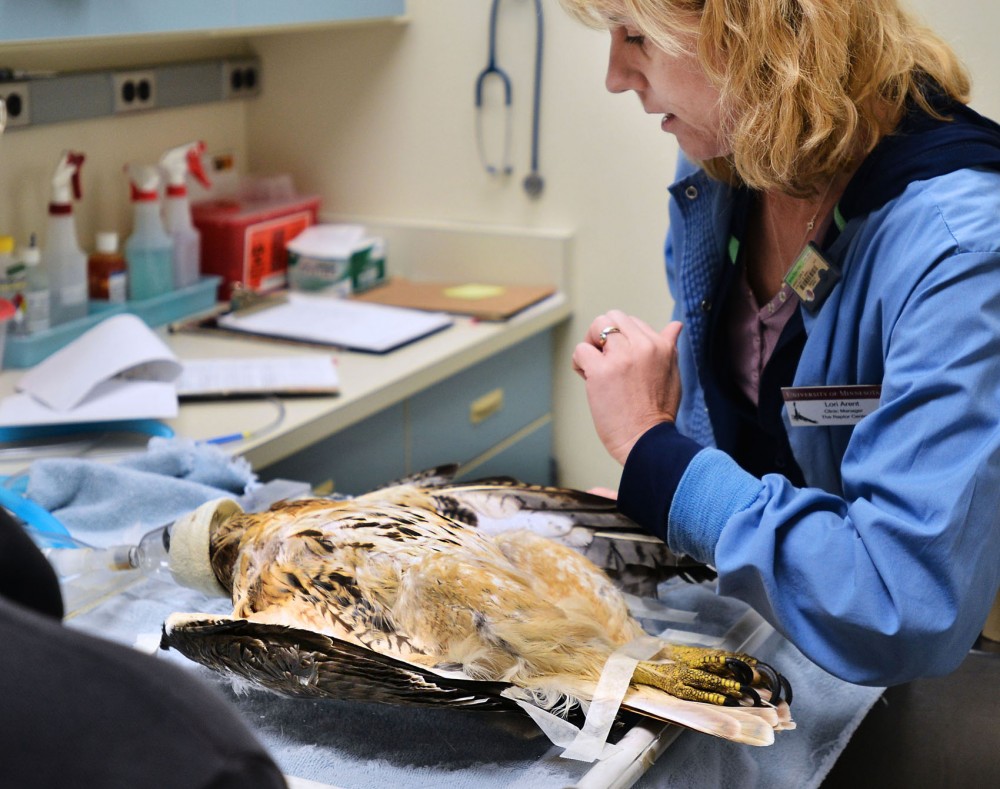Lori Arent performed a final examination on a 4-pound red-tailed hawk Tuesday morning after admitting the bird in April for a broken wing.
After months of intense exercise, she was ready to be released back into the wild Wednesday.
The center’s clinic sees about 20 birds a day from July to November, some of which haven’t been so lucky, said Arent, the clinic manager of the University of Minnesota’s Raptor Center.
The center has seen 17 documented cases of West Nile virus among birds so far this year, according to Raptor Center founder and director emeritus Patrick Redig.
“It’s not a huge number, but it’s substantially different from previous years,” said Redig, who said the center usually sees about one or two cases a year since 2008.
Minnesota has recorded 26 cases of West Nile cases among birds and 65 confirmed human cases, according to the Minnesota Department of Health and the U.S. Geological Survey. Nationwide, there have been 3,545 confirmed cases and 147 deaths reported to the Centers for Disease Control and Prevention this year.
Arent said the cases they saw over the summer were predictive of a bigger year for West Nile virus.
“As soon as we see these conditions in birds, we know it’ll be the same for humans,” Arent said.
High cases of bird infections are found in areas with human infections as well, such as California and Texas, said Redig.
The virus — which first appeared in the U.S. in New York in 1999 — spread through the country. Every mainland state has had at least one documented case within a few years.
“The consensus is that birds are probably moving the virus around more than anything else,” said Dave Neitzel, a Minnesota Department of Health epidemiologist.
Western Minnesota’s North Marsh Lake, home to one of the nation’s largest breeding colonies of American white pelicans, had a significantly increased mortality rate among hatchlings over the summer. Six pelicans sent to the University Veterinary Diagnostic Laboratory tested positive for West Nile virus, said Arno Wuenschmann, a VDL veterinary pathologist.
Veterinarians at the center’s clinic treat West Nile-infected birds with anti-inflammatory medication and supportive care, but “that’s really the only thing we can do,” Arent said.
West Nile cases are presented differently among raptor species, but only a post-mortem examination can verify whether or not a bird was infected, Redig said.
Many factors affect the number of West Nile cases, including infected birds and high temperatures early in the year, which create conditions for increased mosquito populations, Neitzel said.
The Raptor Center first saw West Nile cases among birds in 2002, the same year human cases were first documented. That year, they saw 35 to 40 documented cases, but have seen significantly smaller numbers ever since.
Raptors, along with humans, are often referred to as “dead-end” hosts, meaning the virus will not likely pass on again. But, Redig said, certain bird species are known as “amplifiers,” meaning they can pass on the virus.
Some bird species, like blue jays and crows, can infect mosquitos that bite them within their first few days of infection, while robins can infect mosquitos for longer periods of time, Neitzel said.
He said West Nile has been found in more than 300 species of birds, but the prevalence of the virus in birds is not always indicative of a large human outbreak.
Minnesota is home to 51 different species of mosquitos, many of which feed on strictly birds or strictly humans, so only mosquitos that feed on both humans and birds can drive an outbreak among humans, Neitzel said.
But with temperatures cooling down, he said there may be less cause to worry.
“Most of the virus transmissions are probably over for the year,” he said.

















